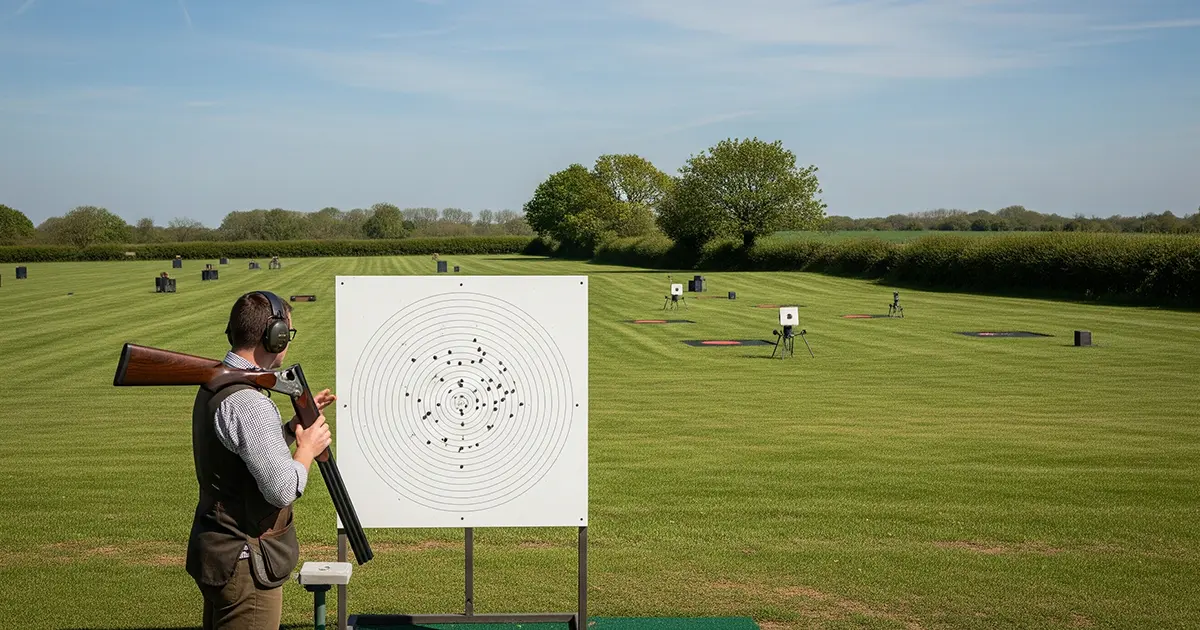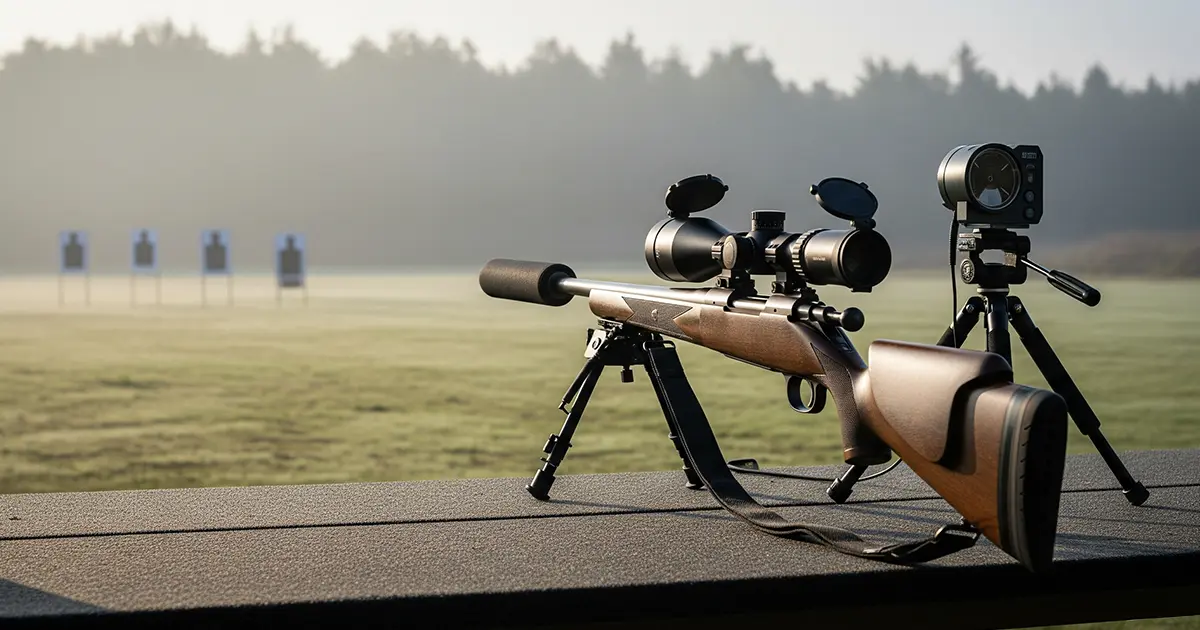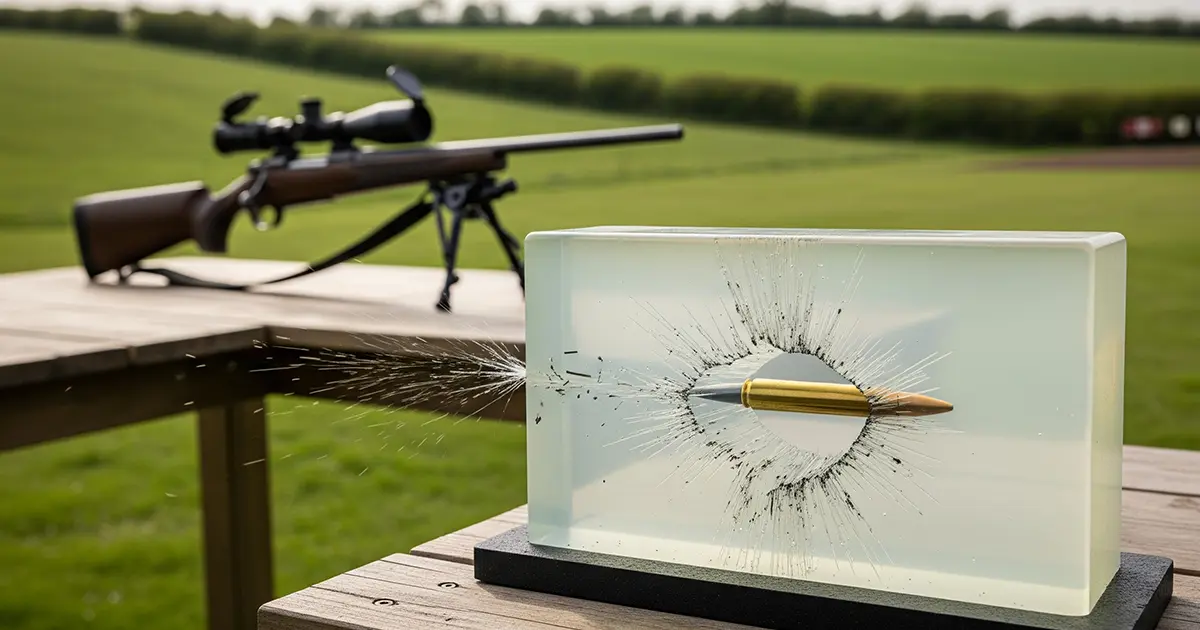Choosing the right choke is simpler when you know two things: how far you expect to break the target, and how your gun and cartridge actually pattern on paper. This guide explains what each choke does, gives practical starting points for clays and live quarry, and sets out the latest UK rules so you can select confidently and safely. It blends technical detail with field-tested tips from The Instinctive Shooter team in Lincolnshire.
“Chokes are tools, not trophies. Start with the most open option that still gives you reliable pellet density at your typical distance, then prove it on the pattern plate. Guessing costs birds and targets,” says David Bellamy, Managing Director at The Instinctive Shooter.
How choke affects your pattern, in plain English
A choke is a small constriction at the muzzle that shapes the cloud of pellets. More constriction gives a tighter pattern at distance, less constriction spreads the pattern sooner. In the UK we traditionally judge patterns by the percentage of pellets that land inside a 30-inch circle at 40 yards. Typical results look like this: Cylinder about 40 percent, Skeet about 50 percent, Quarter about 55 percent, Half about 60 percent, Three-quarter about 65 percent, Full about 70 percent. These are guides, not guarantees, because every gun and load is different. gmk.co.uk, The Field
The quick reference chart
| UK name | Beretta stars | Typical 40-yd pattern | Typical constriction |
|---|---|---|---|
| Cylinder | ***** | ~40% | 0.00 in / 0.00 mm |
| Skeet | – | ~50% | ~0.005 in / 0.13 mm |
| Quarter, Improved Cylinder | **** | ~55% | ~0.010 in / 0.25 mm |
| Half, Modified | *** | ~60% | ~0.020 in / 0.50 mm |
| Three-quarter, Improved Modified | ** | ~65% | ~0.025 in / 0.60 mm |
| Full | * | ~70% | ~0.035 in / 0.90 mm |
Source for mapping, patterns and constrictions: Beretta and GMK choke guide. Treat these as averages, then pattern your own kit. gmk.co.uk
Current UK rules you should know
- Competition ammo and shot size. For CPSA home disciplines, cartridges must not exceed 28 grams of shot and pellet diameter must not exceed 2.6 mm, English size 6. Clay Pigeon Shooting Association
- Ported barrels and chokes. CPSA’s current general rules allow ported barrels and choke attachments in English Skeet, English Sporting, DTL, ABT and other home disciplines. Earlier publications restricted some ported chokes in DTL and ABT, but the March 2023 rulebook confirms they are permitted. Always check event-specific notices.
- Fibre-only grounds. Some clubs now restrict wads or shot types for environmental reasons. CPSA allows registered grounds to impose such limits where risk assessments justify them, for example on SSSIs. Check the ground’s noticeboard before you buy cartridges.
- Lead restrictions. On 10 July 2025 the UK Government announced a ban on most ammunition containing more than 1 percent lead in shot and more than 3 percent in bullets, with limited exemptions and a phased transition. Plan for non-lead options and confirm timelines as the REACH decision is implemented. GOV.UK
Steel, proof marks and choke choice
If you are moving to steel for clays or live quarry, three checkpoints matter:
- Proof marks: High Performance steel requires the CIP fleur-de-lys mark and usually a “STEEL SHOT” stamp on the barrel. Guns with only nitro proof should use Standard steel within appropriate limits. BASC, gunproof.com
- Choke with steel: CIP-aligned guidance recommends Half choke or more open with many steel loads, particularly as shot diameter increases. Tight fixed chokes and large steel shot are a poor mix. sportsmanguncentre.co.uk
- Shot size equivalence: When switching from lead to steel on live quarry, BASC’s trials recommend stepping up roughly two shot sizes, for example lead 5 to steel 3, to retain striking energy. Pattern and test, do not assume. BASC
You can buy dedicated steel clay loads in typical clay sizes, for example 7.5, from UK makers such as Gamebore and Hull. These are designed for venues where lead is not permitted. Check your gun’s proof status and the box markings, then pattern before competition. gamebore.com, gameboreus.com
“The fleur-de-lys mark is non-negotiable for HP steel. If you do not see it, stay with Standard steel within the maker’s limits or choose bismuth. When in doubt, bring the gun to us and we will check it against UK proof guidance,” says David.
Practical starting points by scenario
Use these as starting points, then confirm on a pattern plate with your own cartridges.
English Skeet, club rounds to registered
Targets are near and often crossing. Skeet or Cylinder is the classic pairing. For windier days or Olympic Skeet-style speed, a touch of Quarter can keep the core pattern a little denser without turning the gun into a needle. browning.com
English Sporting and Sportrap
Courses vary. A sensible default is Quarter and Half. On very close stand-one style birds, open to Skeet or Cylinder to avoid “rifling” the target. For long crossers or sim-pairs on a tall tower, step up to Half and Three-quarter if your pattern plate proves it with your chosen load.
DTL and ABT
These are essentially going-away targets. Many competitors favour tighter chokes, for example Three-quarter then Full, to keep a dense core as yardage increases. Test your chosen load at 40 yards, then adjust so the first barrel still forgives a brisk mount. browning.com
Walked-up pigeon or decoying
Keep it ethical and predictable. Quarter and Half give a versatile spread for birds taken from 25 to 40 yards. If you are moving to steel on farmland where lead is restricted, raise shot size appropriately and keep choke at Half or more open unless your proof marks and cartridge brand explicitly approve tighter. BASC, sportsmanguncentre.co.uk
Patterning that actually answers your questions
A pattern plate session turns theory into certainty. Here is a proven, low-faff routine:
- Check point of impact first. At 16 yards, mount naturally, shoot the centre of the plate and see where the shot cloud sits relative to your aim. Adjust your mount or comb rather than chasing it with choke. The CPSA handbook emphasises the value of this stage before you judge patterns. Clay Pigeon Shooting Association
- Measure patterns, not vibes. Step back to 30 and 40 yards, shoot three to five plates per choke and load, draw a 30-inch circle around the densest area, then count pellets inside and out. Compare to the 40-yard percentages in the GMK chart above. Keep notes. gmk.co.uk
- Aim for evenness. Clays and birds are missed through holes, not mystical “tightness”. Choose the most open choke that still gives an even pattern with enough pellets in the 30-inch circle at your real-world distance.
“Most shooters gain more targets by opening the choke a notch and improving the mount than by cranking everything tighter. A forgiving pattern wins on busy layouts,” says David.
Fibre, plastic and pattern myths
Plenty of grounds now require fibre wads. If you switch from plastic to fibre, pattern the gun rather than assuming a big performance swing. Independent testing has shown differences are often modest and very cartridge specific. The key is repeatability, not folklore. Clay Pigeon Shooting Association, Sporting Gun, shotgun-insight.com
Maintenance that keeps patterns honest
Loose or seized choke tubes ruin days out and can damage barrels. Follow the maker’s guidance:
- Keep choke seats and threads clean, lightly oiled, and properly tightened.
- Recheck tightness during a round, especially after long drives or high-volume days.
- Use a quality choke key and proper choke grease if your manual allows.
Author manuals from Beretta set out the routine clearly and are a good benchmark to follow.
Real-world examples we see in the shop
- Close-range skeet problem, too many chips. A customer arrives with Quarter and Half for skeet and complains about inconsistent breaks. We swap to Skeet and Cylinder, then prove on the plate that the Quarter pattern was too tight at his average 20 to 25 yards. His scores rise immediately on low 7 and fast pairs. gmk.co.uk
- Sporting tower crosser, pellets “ghosting” past. On a tall 50-yard crosser, Half gives a sparser edge than expected with his favourite 28 g 7.5s. Moving to Three-quarter restores core density. The pattern plate confirms a true 65 percent result with that cartridge.
- Switch to steel on a fibre-only ground. The ground bans lead and plastic wads, the shooter moves to a 24 or 28 g 7.5 steel clay load and checks his barrels for the fleur-de-lys. We keep his chokes at Quarter and Half, then pattern to confirm evenness at 30 to 35 yards. gamebore.com, BASC
Choosing and buying chokes with purpose
Flush, extended, and aftermarket options all have their place. Quality makers use longer, well-tapered geometries to reduce pellet deformation and improve consistency, which you can verify on paper. If you shoot registered events, current CPSA rules permit choke attachments, including extended and ported designs, but check event notices. teaguechokes.com
“Extended chokes make life easier on wet, cold days because you can change them without a key, and the longer taper of good aftermarket tubes often helps consistency. We still insist on a pattern-plate session before anyone spends money,” says David.
Common Shotgun Choke Questions Answered
How Do I Know Which Choke My Gun Has Fitted?
Most multi-choke barrels have star marks or letters engraved on the tube or barrel flats. If you are unsure, check the maker’s chart or bring it in and we can measure the actual constriction.
Can I Shoot Steel Through Full Choke?
Not unless your barrels are proofed for High Performance steel and the cartridge is marked as suitable. Even then, Half choke or more open is usually recommended because steel patterns tighter than lead.
Do I Need Different Chokes For Fibre And Plastic Wads?
Not necessarily. Some fibre loads can open the pattern slightly compared with plastic, but the only way to know is to pattern your cartridges. Many shooters run the same chokes for both with little change.
Why Do My Scores Drop When I Tighten The Choke?
At closer ranges, a tight choke reduces the effective spread, so small errors in aim can miss entirely. Opening up one notch often gives a more forgiving pattern and better scores.
What Choke Is Best For All-Round Sporting?
Quarter and Half is a proven pairing for most Sporting courses in the UK. They give you enough pattern density for mid-range clays without punishing you on close birds.
Can Choke Choice Fix Poor Gun Fit?
No. Choke controls pattern density, while fit determines where the centre of that pattern goes. If you consistently miss high or low, book a fitting session before changing tubes.
How Often Should I Clean And Grease Choke Tubes?
Take them out after each outing, clean the threads, and apply a light film of choke grease. This prevents seizure and keeps the tubes seating properly for consistent patterns.




